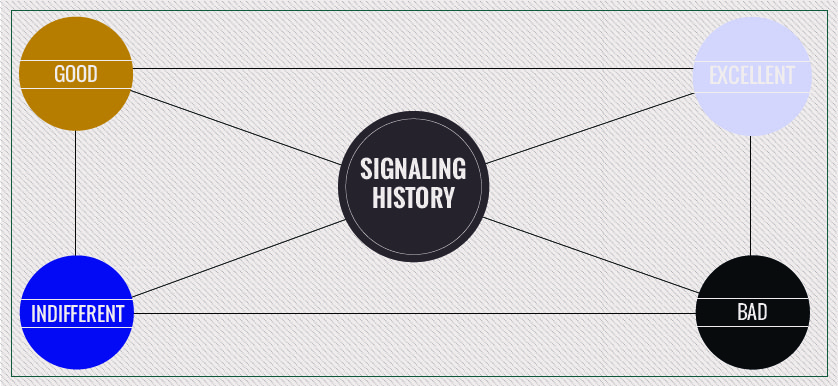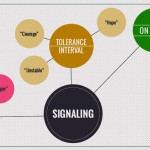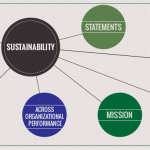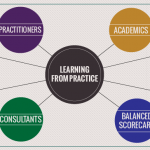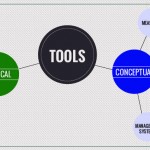Red, yellow and green signaling in performance scorecards – Part 1 – A journey in history
smartKPIs.com Performance Architect update 11/2010
As in all human communication, content and format go hand in hand to deliver a communication message. The content of performance reports only partially addresses communication requirements. Packaging quality content in well formatted reports ensures the message is not only delivered, but the process of receiving, interpreting and understanding is maximized.
Color plays an important part in performance reporting. It fulfills a signaling function, delivering key messages in an efficient and effective manner.
Red, yellow and green are the main colors used today for signaling variance from performance expectations. But it hasn’t always been this way.
Going back in history until the early 1800s, when the first performance appraisals started to be used by companies, we come across a different set of colors. Robert Owen is reported to have initiated the formal appraisals of individual performance management at his cotton mills in Scotland. His “silent monitors” were wooden blocks painted with different colors on each visible side and placed above the work station of each employee (George, 1972; Banner & Cooke, 1984). The color coding was as follows:
- White indicated “excellent”
- Yellow indicated “good”
- Blue was used to indicate “indifferent”
- Black indicates “bad”.
A key development in the history of color coding in performance management was the invention of traffic lights as traffic management systems. Not surprisingly, the industrial revolution and introduction of railways was the catalyst for this invention. John Peake Knight, an engineer working as railway manager is credited as the inventor of world’s first traffic lights, erected in the City of Westminster on the 9th of December 1868 (BBC, 2010). The exact location is reported to be at the intersection of George and Bridge Streets, near London’s House of Commons. The purpose of the traffic light was to direct the traffic of horse drawn carriages and pedestrians, as automobiles arrived in the United Kingdom towards the end of the 19th century. A railway semaphore system was used during the day – with an arm was placed in a horizontal or angled position signaling whether vehicles could pass or not. Gas powered red and green lights were used at night. The color selection was inspired by their use by the railway system.
Red and green signaling is still in use today in railways transportation, aviation and seafaring. It appears the reason for their selection as signaling colors is the wavelength of their light. In railways and shipping, detecting light color from the distance is important as stopping is not as fast as for cars or horse carriages. Lights with higher wavelength are preferred in signaling due to their high visibility.
“Visible light” corresponds to a wavelength range of 400 – 700 nanometers (nm). Outside of this spectrum we have ultraviolet radiation and infrared radiation. The white light is a mixture of the colors of the visible spectrum, while black is total absence of light.
Red light has the highest wavelength of any color: 650 nm. At sunrise and sunset, red or orange colors are present because the wavelengths associated with these colors are less efficiently scattered by the atmosphere than the shorter wavelength colors (e.g., blue and purple). (NASA, 2007). Due to its high wavelength, red is considered to be the color with the highest visibility from distance and the perfect candidate for signaling.
Orange light has a wavelength of 590 nm while yellow light 570 nm, both relatively close to red light, so they were eliminated due to the fact that they don’t offer a high enough contrast.
The next candidate was green light, with a wavelength of 510 nm. It provided the ideal alternative, due to its high wavelength and visibility. The interesting fact about green is that grass appears green because all of the colors in the visible part of the spectrum are absorbed into the leaves of the grass except green. Green is reflected, therefore grass appears green (NASA, 2007).
The Industrial Revolution generated the need for traffic signaling and requirements from the railway traffic management system were transferred to the road one. Gradually, signaling use in the industry transitioned to business.
Stay smart! Enjoy smartKPIs.com!
Aurel Brudan Performance Architect, www.smartKPIs.com
References- Banner, D.K., & Cooke, R.A. , 1982. Ethical dilemmas in performance appraisal. Journal of Business Ethics, 3, 327-333
- BBC, 2010, The man who gave us traffic lights, accessed on 20 March 2010
- George, C. S., Jr., The History of Management Thought, Prentice-Hall, Inc., Englewood Cliffs, N.J., 1972
- NASA, 2007, What Wavelength Goes With a Color? accessed on 20 March 2010.

Tags: Aurel Brudan, Performance Architect Update, Scorecard, Traffic Light

